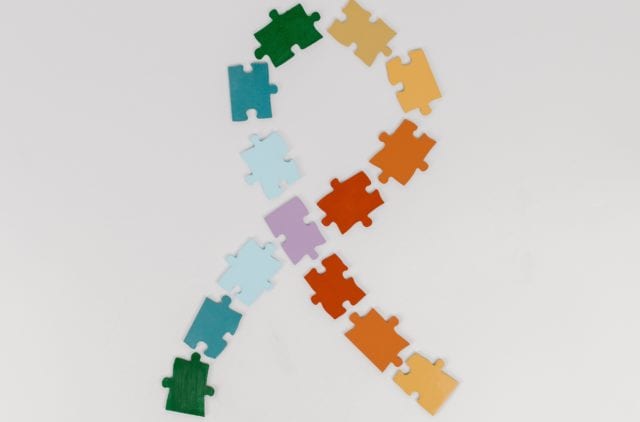Types of Autism: Are there more than one?
Autism spectrum disorder is a developmental disorder mainly diagnosed in childhood. It is called a “spectrum disorder” because the manifestations impairing social interaction, behavior, and communication vary in severity. Although the condition ranging in severity is common knowledge, most are unaware that there are five types of autism.

What is Autism?
According to the Centers for Disease Control (CDC), 1 in every 68 children have a type of autism spectrum disorder—a developmental disorder effecting social interaction, behavior, and communication. The disorder is typically evident in early childhood, and symptoms are lifelong into adulthood.
There are numerous types of autism determined by level of severity and age of onset. It is known as a “spectrum disorder” because each person has varying levels of severities. No two people present the exact same way. While some are debilitated, nonverbal, and withdraw completely from social situations, others have mild social deficits.
Basic Signs and Symptoms of Autism
The majority of the symptoms of autism involve difficulties with social interaction and communication. Regardless of the subtype of autism someone has, the basic signs and symptoms are similar.
- Abnormal Facial Expressions
- Anxiety
- Avoidance of Eye Contact
- Cannot Understand Social Cues (i.e. gestures, body language, etc.)
- Delayed Speech or Language Skills
- Depression
- Difficulty Expressing Emotions
- Echolalia (i.e. repeating words or phrases)
- Hyperactivity
- Lack of Empathy
- Learning Disability
- Light, Sound, or Touch Sensitivity
- Monotonous Speech or Tone of Voice
- Narrow or Extreme Interests
- Prefers Solitude
- Repetitive Body Movements (i.e. rocking back and forth, spinning, flapping, etc.)
- Repetitive Motions with Objects (i.e. opening or closing doors, spinning wheels, flipping levers, etc.)
- Resistance to Change
- Ritualistic Behaviors (i.e. touching objects in a set order, etc.)
- Sleep Disturbances
- Social Withdrawal
Types of Autism: Classic Autistic Disorder or Kanner’s Syndrome
The terms Kanner’s syndrome and Classic Autistic Disorder can be used interchangeably. Classic autistic disorder is the most serious type of autism. The condition is evident in infancy or early childhood. Children with the disorder have severe deficits in social development, behavior, and communication. They have little interest in participating in the world around them. This is the type that has all of the “classic” characteristics of autism: avoidance of eye contact, repetitive behaviors, inability to communicate, and sensory sensitivities. A cognitive delay or poor critical thinking skills are not uncommon. Speech is restricted. In low functioning cases, those with classic autistic disorder are nonverbal or must rely on sign language to communicate with others.
Types of Autism: Asperger’s syndrome
Like classic autistic disorder, those with Asperger syndrome struggle with social interaction and communication. While the types are similar in symptoms, they present less severely. Someone with Asperger’s is generally high functioning. They possess normal intelligence and can navigate the world with minimal support. Although speech may be executed in monotone, there is no speech delay. They attempt social interaction, and show a desire to form relationships, but they do so awkwardly.
Types of Autism: Childhood Disintegrative Disorder
Childhood disintegrative disorder (CDD) is a misleading type of autism. The condition receives its name because children with this type of autism have at least two years of normal development. They meet their milestones such as language, social function, and motor skills, but suddenly regress around age 3. Examples of specific skills that regress are expressive language, social skills, bowel and bladder control, play skills, and comprehensiuon of language.
Neurobiology is thought to be a risk factor contributing to childhood disintegrative disorder (CDD). Researchers report that half of the children with childhood disintegrative disorder (CDD) have abnormal electrical activity in their brain confirmed through an electroencephalogram, and many suffer from seizures (Charan, 2012). This type is also called Heller’s syndrome and disintegrative psychosis.
Types of Autism: Pervasive Developmental Disorder – Not Otherwise Specified
Also known as PDD-NOS, pervasive developmental disorder not otherwise specified is a type of autism that encompasses individuals who meet some of the criteria for autism. According to Autism Speaks, someone with PDD-NOS may have significant deficits in social functioning, but no symptoms in another area like repetitive behaviors or difficulty with organization and planning.
While symptoms of PDD-NOS are relatively mild, parents still notice signs in infancy. However, the condition is not typically diagnosed until age 3 or 4. Recent studies propose unique criteria for PDD-NOS in three groups.
- First Group—The first group is high functioning. Approximately 25 percent of cases account for this group. The symptoms overlap with Asperger syndrome. What separates the first group from Aspergers is that Asperger syndrome does not cause speech delay or cognitive impairment, but PDD-NOS does.
- Second Group—The second group mimics the symptoms of autistic disorder, but does not fully meet all of the criteria.
- Third Group—The third PDD-NOS group is comprised of 50 percent of cases. Someone with this type has relatively mild repetitive behaviors, but extensively meets the other criteria for autistic disorder.
Types of Autism: Rett Syndrome
Rett syndrome is a rare genetic neurological disorder that affects brain development. The primary symptoms include loss of speech, sleep disturbances, trouble breathing, loss of mobility, seizures, and scoliosis. Although now discontinued as a type of autism, the condition was once classified as autism due to the developmental delays and repetitive hand movements. It mainly occurs in females between the ages of 6 and 18 months.
Diagnosing Types of Autism
There is no single test to diagnose autism. An autism screening consists of a thorough family history in which a medical physician, usually a pediatrician, evaluates the patient for the early signs of autism spectrum disorder. These include but are not limited to delays in communication, avoiding physical contact, failure to accept changes in daily routine, and more. Assessments for autism are now part of routine 18 and 24-month checkups.
If the physician suspects autism, they base the diagnose on the criteria listed in the Diagnostic and Statistical Manual of Mental Disorders (DSM-5):
- Persistent deficits in social communication and social interaction
- Restricted and repetitive patterns of behavior, interest, or activities
Some medical doctors prefer to screen patients using a variety of screening tools prior to referring them to a specialist. The tools assess behavior, cognitive skills, and social developments indicative of autism spectrum disorder if delayed.
- Parents’ Evaluation of Developmental Status (PEDS)—A parent interview to give input about the child’s developmental delays like motor skills, language, and more
- Modified Checklist for Autism in Toddlers (M-CHAT)—A 20-question test for toddlers between the ages of 16 and 30 months old.
- The Ages and Stages Questionnaire (ASQ)—Identifies developmental challenges at specific stages of life
- Screening Tool for Autism in Toddlers and Young Children (STAT)—An interactive set of activities designed to evaluate communication, imitation, and play

Types of Autism: Types of Professionals
Autism is a complex condition requiring the help of many medical and educational professionals. Initial screening is typically performed by a pediatrician or general practitioner. However, psychologists, social workers, teachers, and hearing and vision specialists also play a large role in diagnosis and treatment.
- Social Worker—Coordinates care between the family and team.
- Educational Aid—Works with the child in a classroom setting.
- Physical Therapist—Monitor issues with motor skills and movement such as mobility, balance, and posture.
- Special Educator—Creating an educational plan including the academic skills needed from the school.
- Speech-Language Pathologist—Diagnoses and treats any underlying or secondary disorders associated with speech, communication, language, and feeding.
- Physicians—First, medical doctors rule out medical causes prior to diagnosis. Once autism is diagnosed, they prescribe medications to improve symptoms.
- Psychologist—Tips for how to cope with social interactions including understanding social cues, managing school, work, and relationships
- Occupational Therapist—Provide patient and families with the resources to cope and adapt to daily living; assists with motor skills (i.e. writing, coloring, grooming, independent dressing, cutting with scissors, using forks/knives while eating, etc.).
Levels of Autism
Levels of autism are based on the amount of support needed for the patient to function. Determining the level is important for physicians and caregivers to apply the appropriate interventions. There are three levels.
Level 1: Requiring Support
Level one autism is the mildest presentation. Those categorized as level one are “high-functioning” and require minimal support. They struggle with social interactions. Initiating conversation and maintaining interest in conversation are difficult. Sometimes they say the wrong thing due to the inability to read social cues and body language. Change makes them uncomfortable. They need assistance with organization and planning.
Level 2: Requiring Substantial Support
Someone who meets the criteria for level two have significant deficits in social functioning. Social function is limited to special interests. They may speak in short sentences and only seek conversation about certain topics. They become extremely upset when their daily routines change. Restrictive and repetitive behaviors are more prominent. Coping with stress is the area in which they require support.
Level 3: Requiring Very Substantial Support
Level three is the most severe in autism presentation. They require substantial support because they understand little verbal and non-verbal communication and fail to express themselves. Interactions with others are limited. They do not show interest in making friends. High stress situations provoke extreme distress, and they cannot alter their focus once disrupted. They engage in repetitive behaviors such as flicking of the fingers, opening and closing doors, rocking back and forth, and spinning in circles. Their disability is very evident.
References
Charan S. H. (2012). Childhood disintegrative disorder. Journal of pediatric neurosciences, 7(1), 55–57. https://doi.org/10.4103/1817-1745.97627
Cheyanne is currently studying psychology at North Greenville University. As an avid patient advocate living with Ehlers Danlos Syndrome, she is interested in the biological processes that connect physical illness and mental health. In her spare time, she enjoys immersing herself in a good book, creating for her Etsy shop, or writing for her own blog.